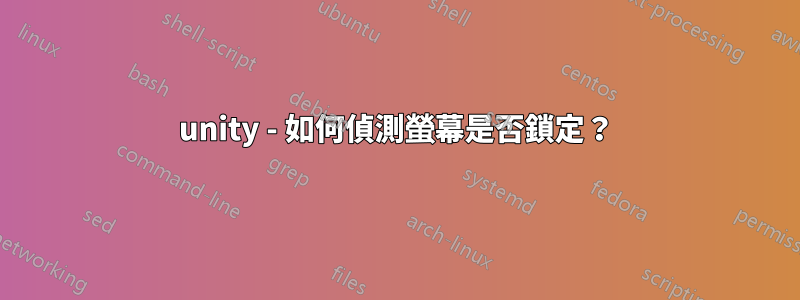
這兩種方法僅在鎖定的螢幕變為空白後才起作用;但有時也會失敗,當由於某種原因畫面不空白時...
gnome-screensaver-command --query
gnome-screensaver-command --time
我也嘗試過qdbus:
qdbus org.gnome.ScreenSaver /org/gnome/ScreenSaver org.gnome.ScreenSaver.GetActiveTime
但同樣失敗了。
我剛剛發現,真正鎖定畫面的是Unity!
qdbus com.canonical.Unity /com/canonical/Unity/Session com.canonical.Unity.Session.Lock
相關問題:
https://unix.stackexchange.com/questions/28181/run-script-on-screen-lock-unlock
https://unix.stackexchange.com/questions/80143/how-to-create-a-daemon-which-would-be-listening-to-dbus-and-fire-script-on-messa
答案1
水瓶座力量的答案似乎效果很好。以下是我可能對他的解決方案進行的一些補充。
只查詢鎖定狀態
如果您只需要一行程式碼來查詢鎖定狀態,則如果已鎖定,則應評估為 true,如果未鎖定,則應評估為 false。
isLocked=$(gdbus call -e -d com.canonical.Unity -o /com/canonical/Unity/Session -m com.canonical.Unity.Session.IsLocked | grep -ioP "(true)|(false)")
查詢鎖狀態和追蹤自上次狀態變更以來的時間
現在,如果您需要追蹤螢幕鎖定的時間,您可能需要採取不同的方法。
#!/bin/bash
# To implement this, you can put this at the top of a bash script or you can run
# it the subshell in a separate process and pull the functions into other scripts.
# We need a file to keep track of variable inside subshell the file will contain
# two elements, the state and timestamp of time changed, separated by a tab.
# A timestamp of 0 indicates that the state has not changed since we started
# polling for changes and therefore, the time lapsed in the current state is
# unknown.
vars="/tmp/lock-state"
# start watching the screen lock state
(
# set the initial value for lock state
[ "$(gdbus call -e -d com.canonical.Unity -o /com/canonical/Unity/Session -m com.canonical.Unity.Session.IsLocked | grep -ioP "(true)|(false)")" == "true" ] && state="locked" || state="unlocked"
printf "%s\t%d" $state 0 > "$vars"
# start watching changes in state
gdbus monitor -e -d com.canonical.Unity -o /com/canonical/Unity/Session | while read line
do
state=$(grep -ioP "((un)?locked)" <<< "$line")
# If the line read denotes a change in state, save it to a file with timestamp for access outside this subshell
[ "$state" != "" ] && printf "%s\t%d" ${state,,} $(date +%s)> "$vars"
done
) & # don't wait for this subshell to finish
# Get the current state from the vars exported in the subshell
function getState {
echo $(cut -f1 "$vars")
}
# Get the time in seconds that has passed since the state last changed
function getSecondsElapsed {
if [ $(cut -f2 "$vars") -ne 0 ]; then
echo $(($(date +%s)-$(cut -f2 "$vars")))
else
echo "unknown"
fi
}
本質上,該腳本監視螢幕鎖定狀態的變化。當發生變更時,時間和狀態將轉儲到文件中。如果您喜歡或使用我編寫的功能,您可以手動閱讀此文件。
如果您想要時間戳而不是秒數,請嘗試:
date -ud @$(getSecondsElapsed) | grep -oP "(\d{2}:){2}\d{2}"
不要忘記-u強制日期程序忽略您的時區的開關。
答案2
螢幕實際上是被Unity鎖定的,並且,我們需要使用gdbus
gdbus monitor -e -d com.canonical.Unity -o /com/canonical/Unity/Session
這將顯示它何時被鎖定,如下所示:
/com/canonical/Unity/Session: com.canonical.Unity.Session.LockRequested ()
/com/canonical/Unity/Session: com.canonical.Unity.Session.Locked ()
/com/canonical/Unity/Session: com.canonical.Unity.Session.UnlockRequested ()
/com/canonical/Unity/Session: com.canonical.Unity.Session.Unlocked ()
答案3
我有一個類似的問題這裡
我得到的幫助與 Aquarius Power 之前所說的類似,除了它包含在 bash scrip 守護進程中,可以在後台運行..我發現它非常有幫助。所以,看看我的問題並回答,看看這是否也對您有幫助。


